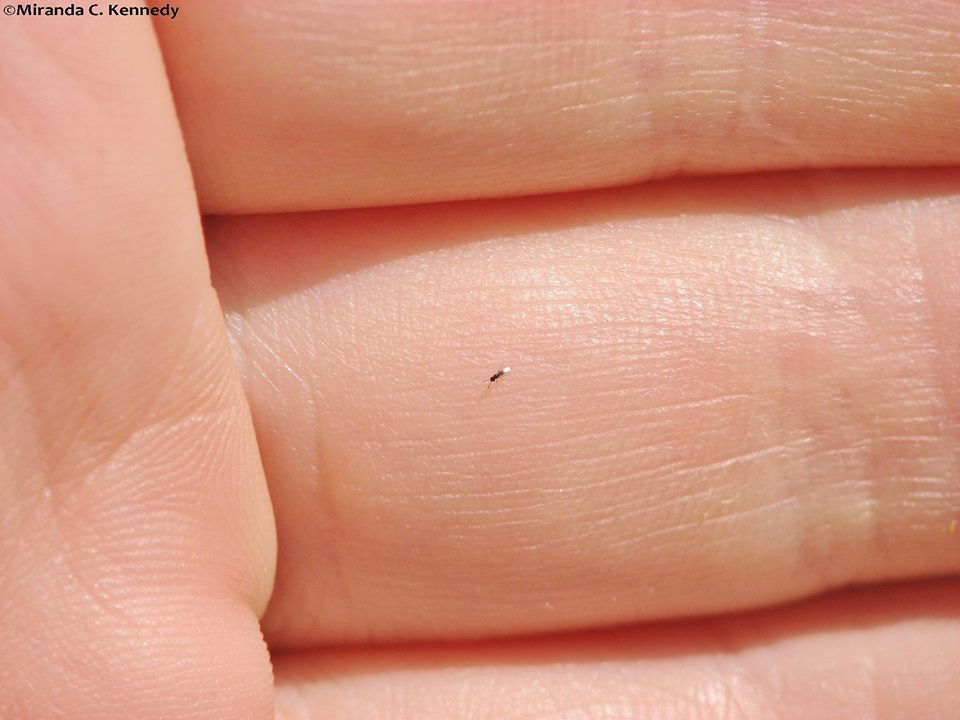Natives
- Animals, Bees, Chickens, Cob, Compost, Composting toilet, Gardening adventures, Health, Heirloom Plants, Herbs, Natives, Permaculture and Edible Forest Gardening Adventures, Ponds, Rain Catching, Recipes, Salads, Soil, Vegan, Vegetables, Vegetarian, Worms
Southern California Permaculture Convergence! Be there!

Southern California Permaculture Convergence If you are interested in any aspect of permaculture, such as organic gardening, herbs, planting native plants, aquaponics, natural ponds, beekeeping, keeping chickens, and so much more, then you must come to the Southern California Permaculture Convergence. It happens on March 9th and 10th at the Sky Mountain Institute in Escondido. The keynote speaker will be Paul Wheaton, lecturer and permaculturalist extraordinaire of www.permies.com fame. Oh, and I’ll be one of the many speakers as well (cough cough). The Early Bird special of only $50 for both days ends at the end of January, and then the price will rise, so buy your tickets now!
Also, for a full-on demonstration of taking bare land and creating a permaculture garden, there will be a three-day intensive class taught by Paul Wheaton on site the three days prior to the Convergence.
You can read about the convergence here at the official website, which will give you the link perm.eventbrite.com where you may purchase tickets. Also visit the SD Permaculture Meetup page to see all the free workshops that happen monthly all over San Diego.
This convergence is such a deal, you really shouldn’t miss it! And such a bargain, too. One of the best things I find that come out of these convergences is the exchange of ideas and networking among the attendees, and all the practical information you can take home and use right away. One of the largest parts of permaculture is building community, which means sharing with and assisting others.
Really. Don’t miss this! Tell your friends!
- Compost, Gardening adventures, Natives, Permaculture and Edible Forest Gardening Adventures, Soil, Vegetables
Gardening secrets: Epsom salt and sugar

This veggie bed soil isn’t very active. So I buried frosted tomato vines in it and sprinkled on my powerful duo, and in a month I’ll plant seeds. Gardening shouldn’t be expensive. If you believe everything you read, especially those wonderful gardening catalogs and even advice from professional gardeners, a garden could be quite an investment. Talk about golden carrots! I have spent my fair share of money for gardening products in my time. Then this permaculture stuff got into my head and it makes me rethink everything. Permaculture proves that gardening shouldn’t be labor intensive, just labor-wise. Make things work for you and let plants get on with what they want to do. Makes some forehead-slapping sense to me.
Organic fertilizer is a plus for firing off poor soil, but it is expensive. There are two other very inexpensive household products that you can use to really charge your soil, promote growth, make fruit sweeter, reduce some weeds, release the bound-up vitamins and minerals in the soil, promote world peace… well, I’m getting a little carried away, but not by too much.
Epsom salt is named after Epsom, England, where the active ingredient Magnesium sulfate was originally created. Not found naturally, it must be processed, now most often from dolomite. Dolomite is mined in the United States and internationally. The sustainability of dolomite mining and the environmental impact of mining, processing and shipping Epsom salts may be something to consider, if you worry about the locality of products you purchase. I don’t know what impacts those are. Epsom salts can actually be made at home by chrystalizing magnesium sulfate, but I’m thinking that although I enjoy do-it-yourselfing, this is a little too much.
Epsom salt is inexpensive and readily available. It is recommended for tomatoes, peppers and roses, but I use it around citrus trees, in the veggie beds, and anywhere leaves are looking sickly. The Epsom salt bag recommends sprinkling 2 tablespoons around the base of each plant, so you can see a little goes a long way. It is also a wonderful bath salt which eases sore muscles and leaches impurities from your skin (often recommended as a diet aid because of this). (Also if you have a greywater system, your magnesium-enriched bathwater will flow out to nutrify your plants! Such a deal!) Some sites tell you never to take it internally; the bag and others recommend it for… let’s say… loosening things up inside. It is also used as a curdling agent in making tofu. There is a relationship between calcium and magnesium whether it be in the soil or in our bodies. Taking too much calcium without enough magnesium can lead to many health problems such as arthritis and hardening of the arteries. Don’t take more than a ratio of 2:1. (Dairy products don’t have that ratio, so if you drink milk you may not be absorbing the amount of calcium you thought you were). Also, calcium and potassium compete with magnesium for uptake into roots, and even though your soil samples may indicate enough magnesium your plants may not be receiving enough. If you have heavy clay soil, you could have a ratio as high as 7:1, yet in sandy soil you need more magnesium to hold soil together so you can go to about 3:1. Here are some good sites for looking into the science behind it if you’re interested: National Gardening Association, a book excerpt here which goes into more details about how its made and how to use it medicinally, and even a site about how to make crafts with it.
Also, don’t let the name confuse you. Epsom salt is Magnesium sulfate, not salt as in table salt which is Sodium chloride. Applying Epsom salt to the ground is not like applying, well, salt. Applying Sodium chloride to your soil is to kill it. I’ve read and overheard inexperienced gardeners say that they’ve poured salt on weeds because, after all, it comes from the ground so it shouldn’t do any damage. Ummm, no. Invading armies would salt the fields of their enemies so they couldn’t grow crops there for decades. Heavy salt in the soil is a huge problem (which, of course, if you’ve been paying attention to past blogs you know can be readily solved by….. what? I’ll give you a chance to fill that in and reveal the answer at the end!)
As for my other ‘secret’ ingredient is sugar. Yes, my soil is on junk food. Actually using organic molasses dissolved in rainwater would be best, and I have done that when making a microbial brew, but I am but one person with a thin purse so sugar it is. Why sugar? It is a complex carbohydrate which plants need to produce protein, starch and fats. Plants produce their own sugar through photosynthesis, and by secreting their own sugars through their roots determine which microorganisms they want to thrive near them. I use a little sugar on ailing soil; all those millions of microbes and fungusey things that are in the soil get a jump-start with something sweet. Have you ever made bread and mixed a little sugar in with the yeast to proof it? Same difference. The soil critters feed off the sweet, multiplying like crazy and making your soil turn into healthy goodness. If your soil is healthy, you don’t need it. When the sweet is gone they munch on organic materials processing them more quickly and opening up all those locked nutrients in the soil. If there isn’t enough for them to eat and there is a die-off, then their little bodies become nutrients for the soil (as they would anyway). To put this into perspective, let me relay to you an interesting fact I learned in my Permaculture Design Course. When a field is plowed and farmed, the first year crops are good. Each successive year that it is plowed and farmed the fertility is less and the crops worse until the ground is barren. That is because with the first plowing or tilling gajillions of microbes are slaughtered and it is their dead bodies that fertilize the crops. Each successive year there are fewer microbes available to slaughter until they are all gone and the soil has become dirt. And then we have dust bowls and run-off, erosion, loss of the water table, the drying up of streams, climate change, universal discord… well, you get the picture.

Climbing Don Juan here was a miserable, spotty rose last Spring, while all his friends were tall and lovely. I added Epsom salt and sugar, and he fought off the black spot and is thriving. Only lightly sprinkle the sugar around your soil; too much can hurt plants. I have used sugar successfully to kill off an invasion of nutgrass, something about which I read on the Internet. This sedge turned up in my pathways and although I hand weeded the little guys (I didn’t eat them although they were cultivated as a crop in Egypt) they just kept on coming, even after I had put plywood over the top for awhile. So I sugared them then threw the plywood back on, and Bob’s your Uncle, no more nutgrass in that area. I envisioned millions of little mouths biting away at the nutgrass bulbs underground… I need to stop thinking about that. What really happened is that the microbes fed off the sugar and multiplied wildly to a point where they locked up the available nutrients in the soil which non-natives need to grow. Native plants won’t be bothered because they can thrive in poor soil. Here is an article about the research behind sugaring to prevent weeds. I lightly add sugar around established plants that aren’t doing well, and water into new vegetable beds where the soil isn’t vigorous yet and allow the beds to sit awhile before I plant seeds.
Refined white sugar is of course empty calories. Any dissolved sweet will work well, too. Beet sugar, agave syrup, leftover pancake syrup, sorghum syrup, honey, molasses, diluted jelly… use your imagination and your pantry. The more nutrients in the sweet the better for your soil, but also the more expensive it will be. If you are using sweet for houseplants then you should be wary of possible interest by house ants. Outside it isn’t a problem.
So share your bath and your jelly donut with your garden and you’ll both be happier and healthier!
(Answer: compost! You knew that!)
- Compost, Gardening adventures, Giving, Health, Natives, Permaculture and Edible Forest Gardening Adventures, Soil, Vegetables
Stinging Nettle and World Peace
One of my very good friends asked me what to do about a proliferation of stinging nettle in her yard. There is a creek running through the bottom of her property, and while once there had been Jimson weed and other natives growing there, now there is just nettle which is spreading to her lawn. Her hand hurt for a day from inadvertently pulling some out bare-handed. Her neighbor had told her that “nettle was bad” and would take over. She was laying cardboard on some of it, but was afraid that wouldn’t be enough.
One of the main practices of permaculture is to take what is considered to be a problem and look at all sides of it, just as in Zen you must think like your enemy, or in some Native American beliefs you must walk a mile in another’s shoes.
Fortunately I knew some things about nettle, and told her that nettle was not only edible once the acid had been blanched away, but highly nutritious. Here is a good description of what it can do. It is a superb compost enervator. The disappearance of the other natives by the streambed was evidence that someone upstream had sprayed an herbicide that washed downstream and killed everything. The prolific growth of stinging nettle, which is an indicator plant for high nitrogen in the soil, showed that someone’s high nitrogen lawn fertilizer came the same way.
Nettle’s acid is simply an excretion by the plant on the hairs along its stem to discourage browsing animals. The sting is immediate and temporary, unlike poison oak which has an irritating oil that can spread with touch and takes a few days to cause a rash. In nature often the cure grows near the problem, and therefore both the riparian plants mint and plantain can be rubbed onto the area to alliviate the sting, but soap and hot water works just as well. Nettle reproduces only by seed, not by rhizomes or other invasive tactics. It likes water therefore it takes root in lawns which are watered frequently and are fertilized with nitrogen.
My friend is always ready to embrace new information, especially where nutrition is concerned, and immediately stopped looking at nettle as a potentially dangerous invader of her property, to an indicator of other problems (stream pollution) and a health goldmine. To control what she doesn’t use she knows she can cut it down before it seeds and it won’t spread (and the cut plants will charge her soil), and if she wanted to restore the wetlands area she could continue to lay cardboard to cover most of the nettle, then top them with soil and straw, cut holes through to the dirt and transplant native riparian plants into the sheet mulch. There are no invaders, no monsters in her yard.
While pulling ragweed out of the pathways at my place with another friend (I have become so rich in friends this last year!), I told her about the nettle. Her reply was that while she worked in the garden she’d see things in a new perspective. Knees to the earth, eyes choosing between ragweed and sprouting wildflowers, lungs full of the scent of good soil, permaculturalists steer away from the stereotypcial gardening approach and see benefits where others see problems.
And this is what this post is all about: applying permaculture practices to everyday living, from personal to global thinking. In permaculture there are no invasives, no bad guys. Even my hated Bermuda grass is a plant in the wrong place, spread because people insist on seeding lawns with the stuff. Its function is to hold soil and moisture and break up hardpack. It does this admirably well, only I don’t want it in my garden. In permaculture, problems are like little moons where you see nothing but black on the dark side until you turn it to see the incredible sunlit topography on the other side, and understand that all those details are there on the dark side as well. A problem is just an opportunity for creative thinking; a resource whose purpose isn’t clear as yet. Therefore there are no ‘weeds’, no stereotypes.
So take these phrases and look at them with the eyes of permaculture: Teens are irresponsible. Old people are antiquated. Dark-skinned people are dangerous. Light-skinned people are dangerous. The government is out to get us. All businesses are bad. All politicians are corrupt. Men are incompetent. Women are hysterical.
Imagine these phrases as balls you can turn in your hand, like little moons. Examine, understand, see that anger and violence all stems from fear. Look at all sides of the phrases and see that they cannot be true. Just as stinging nettle isn’t an invasive plant out to get people, but a plant rich in potentials doing its job, then any potential imagined threat to our safety can be understood and appreciated until we no longer face it with fear. We hire and train youths. We listen to the life experience of the old. We vote to change the government. We support small businesses. We offer training and workshops to teach. We offer safe, sane gardens in which to meditate. We produce good organic food to nourish brains and bodies and activate good health.
By gardening with permaculture in mind we can so easily imagine a more peaceful world, both for our small personal worlds and on a global scale. Therefore it is imperative that we introduce others to permaculture, for the saving of the earth and of ourselves.
- Animals, Gardening adventures, Natives, Other Insects, Permaculture and Edible Forest Gardening Adventures
At Least 78 Reasons Why You Shouldn’t ‘Clean Up’ Your Garden
The idea of cleaning up all the dead plants out of the garden in the Fall has been so drilled into us that it is almost second nature. There are a certain amount of things to do in a garden in the Fall, but second-guessing nature’s usage of plants shouldn’t be one of them. Leaving seedheads standing provides birds with something to eat when scavenging becomes difficult – and for a perch. Not being so radical about cutting back or pulling out plants that don’t look as good as new may provide you with pleasant surprises. For instance, last month I saw that milkweed plants had been eaten down by Monarch butterfly larvae until there wasn’t a leaf on them. The caterpillers were gone and there were a couple of the beautiful Monarch butterflies landing on the lantana and butterfly bush for a drink. I left the plants, and sure enough, they produced more leaves. Then this week, the week before Thanksgiving – so late in the season – I happened to look at the milkweed and saw that it was bare again.

A bare looking milkweed plant. Then I took a closer look.

And then I stared.

One one milkweed plant there were well over fifty Monarch caterpillars, and on a smaller plant over twenty.

They were hurrying to eat what they could.

Many wouldn’t make it through metamorphosis this late in the season, but many will.
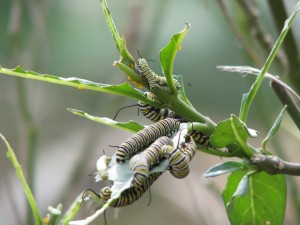
However I’ve since seen these beautiful creatures all over the yard looking for suitable places to fasten on to, to form their green and gold cases and try their luck at metamorphosing. Perhaps there will be Monarchs in the yard at Christmastime.

I’m glad that I’m a sloppy gardener.
- Compost, Gardening adventures, Natives, Permaculture and Edible Forest Gardening Adventures, Soil, Vegetables
Leave the Leaves

The world can be saved with leaves. Yep. No kidding. We are in a season named after leaves: Fall. When deciduous trees drop their leaves they are shutting down their systems for the winter. In warm climates native plants don’t do this, rather they shed leaves over a period of time, never turning off their ability to create food through photosynthesis. Evergreens also do this, providing shelter and food for animals no matter the weather. In cooler climates many trees go into semi-dormancy, kind of a half sleep.

Liquidamber trees provide gorgeous Fall color and lots of great leaves. They reduce the number of leaves on their branches so that their productivity reduces but doesn’t completely stop. In cold climates many trees become living works of art as their leaves turn colors before falling. Much has been made of the beautiful sight of bare branches in a winter garden. A traditional Fall activity is the raking and disposing of fallen leaves. Happy kids jumping into leaf piles. However, we need to stop thinking that bare is beautiful; at least, as far as the soil is concerned.

Plant trees that will provide you with lots of leaves. The disposal of fallen leaves should be made an environmental crime. Trees drop their leaves to protect and feed their roots, and all the microbes that aid and abet them. Those decaying leaves also protect and feed bulbs, shrubs and other overwintering plants. Ever notice how snow melts around leaves and fallen branches first? That is because they also produce warmth as they decompose, warming the soil to keep the microbes alive.

The whiteness is fungus breaking down the twig. The leaves are breaking down into rich, fragrant soil. To remove fallen leaves is to take away the tree’s food, nutrition, its disease and pest control by pest control san diego and ultimately its health. It would be as if you had stored up a cabin for the winter with healthy food and supplies, and someone came and took most of your supplies except junk food, took your blankets, your firewood and your vitamins and medicines. You’d probably survive until Spring, but you wouldn’t be very healthy, and you’d stay in a hospital and be treated with drugs to combat the illnesses and injuries you accumulated. Your health would be greatly weakened.

A young sycamore just starting its leaf accumulation. This is what leaf removal does for trees. People rake up the leaves in the Fall, then in the Spring buy fertilizer (usually chemical thanks to persuasive advertising), insecticides, foliar sprays and other junk that they don’t need, take time and effort and mess to apply, are often a human health hazard if inhaled or touched, and are expensive. None of this is necessary, if people would only do less work and stop interfering. If they would leave the leaves, plant companion plants around the trees along with natives, everyone would be healthier.

Rich avocado mulch. People rake leaves and dispose of them because the leaves come from specimen trees usually dotted around lawn areas. Lawns are unnatural. Fun, pretty, functional, but unnatural. Grass doesn’t like leaves on top because the leaves block the light. Exactly. A layer of leaves around the base of the tree will prevent invasive weeds and grasses from stealing rich topsoil.

Citrus leaves and fruit. Even in grove situations, or under fruit trees, people are determined to clear every leaf off the surface of the dirt. Notice I say dirt, not soil. The trees know what they are doing; they know what they need and dropped leaves and fruit are there on the ground for a purpose. They feed the soil and thus the tree.

Leaving vegetable vines to decompose enriches your garden beds. What can be the compromise? Allow the space under your specimen trees to be cleared of grass up to and a little beyond the drip line of the tree; further would be better. When leaves fall, rake them all under the tree, being careful not to pile them up around the trunk. Plant all the shade-loving plants and bulbs that you’d like to within that space, but include members of a plant guild: a nitrogen-fixer, a groundcover, a deep tap root that mines the soil, a mulch plant, a pollinator, etc.

A leaf haven. This old oak has a large root base. I collect the leaves off the stairs only, and they are used to charge the soil under new oaks. Children like to play under the trees? Afraid of creatures lurking in the leaves? Then leave a space for human interaction. Make a barrier with stones or decorative edging that circles a little more than the drip line of the tree, but then cuts back to the trunk to leave a large wedge shape. Leave the leaves and fruit within the barrier, and keep the wedge clear for sitting and playing.

California peppers are one of many trees that drop leaves which emit a chemical that discourages competition from other plants. Still too many leaves? In their natural settings deciduous trees produce leaves enough to cover their roots and also the space between trees, which protects the fungal passageways that connect the tree roots. With a specimen tree that isn’t happening. What to do? Compost! Build an inexpensive bin with wire or pallets and cram the leaves in. Each leaf is a vitamin pill for your garden. Go in with your leaf-burdoned neighbors on the rental of a shredder and shred everyone’s extra leaves. Mulch all your garden beds and your lawn with shredded leaves. They will break down faster, heat up more quickly in a compost heap and take up less space. Your soil will turn into rich, fragrant loam.

Pine needles are high in acid; great to even out alkaline soils. Stilltoo many leaves? Post ‘free clean leaves’ on Craigslist or on your community bulletin board. Gardeners crave leaves, and may even come out to rake them up for themselves.

I only wish the leaves were this deep! The broom is just worn to a nub. Please, please don’t send your excess leaves to the landfill. The soil desperately needs those leaves and with them you won’t have to resort to chemical fertilizers, chemical sprays, high expenses and heavy labor in the Spring. You can instead spend the time watching your garden thrive.
- Gardening adventures, Natives, Other Insects, Permaculture and Edible Forest Gardening Adventures, Soil
Native Planting

Milkweed and wildflowers are host to butterflies, and the garden is still full of them. Today the forecast searing sun hid behind clouds all morning, making it a perfect Fall day for planting natives. The area all along the northern property fenceline is dedicated to plants found in our San Diego coastal sage scrub habitat. The dirt along this area is bad. It is sandy dirt over hard clay, a product of years of runoff flowing in from the neighbor’s yard.

The native California strip with dirt, not soil. Last year coastal live oaks, cork oak and Engelmann oak were planted along this strip, and little else. The soil was covered with sheaths of palm leaves, and they helped protect the soil and hold in some moisture, but there is little decomposition rate from them. The soil needed oak leaves.
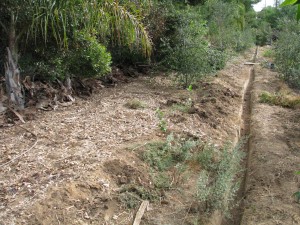
A coating of oak leaves will help fire the soil; more leaves will be coming soon. Last Monday Lori, a friend who is working here weekly did a tremendous job carefully raking back all the palm sheaths, then bagging oak leaves from the walkways around the massive old oak on the embankment and spreading them around between the new oaks. There are plenty of leaves left for the health of the big oak; just the leaves on the slippery stairs were moved. The oak leaves will decompose and provide the soil with the nutrients to host fungal action in the ground; the start of soil building.

Planting lemonade berry and sugarbush. Today Jacob and I planted a number of lemonade berry, sugarbush and deerweed, as well as two replacement coastal live oaks. I had purchased packets of seed mixes as well as several types of lupine (nitrogen fixer), making sure there was no alyssum, evening primrose or borage in the packets (they do very well on their own on the property!).
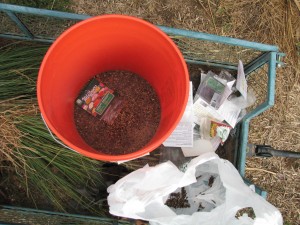
Take a lot of seed packets, empty them into a bucket, stir and voila! Diversity! I also took some seedheads from a couple of non-native sunflowers and threw them into the mix.

Breaking up a sunflower for seeds. In every damp spot from the subterranean irrigation we planted wildflower seeds.
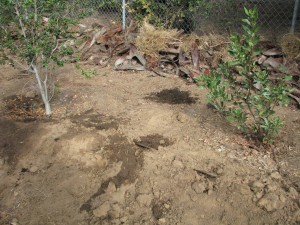
The subterranean irrigation leaves damp spots on the soil, where I plant flower seeds. They’ll choke out future weeds as well. We’ve had stunning results from this method for several seasons. It is the middle of October and there are still flowers blooming, providing beauty and food for insects and birds.
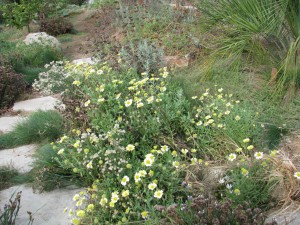
Stands of wildflowers feed the insects and look wonderful. Some herbs such as purple basil and parsley have come up late.

Purple basil showing up between the last of the squash vines. Either I use it or let it go to seed to feed insects and reseed itself. California poppies that have died off are showing new leaf growth around the base of the plants. So all-in-all a very successful day, thanks to the hard work of my helpers and the cooperation of the weather. These native plant guilds of plants, mulch and flowers will all work towards turning that soil alive and begin the communication between the native plants that will make this habitat for native animals priceless.
